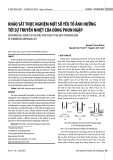
TNU Journal of Science and Technology
229(06): 247 - 258
http://jst.tnu.edu.vn 247 Email: jst@tnu.edu.vn
PHYTOREMEDIATION FOR LEAD-CONTAMINATED SOIL
Luong Thi Thuy Van*, Hoang Thi Chanh, Cao Thi Phuong Thao
TNU - University of Education
ARTICLE INFO
ABSTRACT
Received:
08/4/2024
Lead-contaminated soil poses a serious concern for agricultural
production, food safety, and human health due to its detrimental effects
and widespread accumulation in food chains. Phytoextraction, the
extraction of pollutants using plants, is a technology that has been
researched and applied to extract or remove lead from polluted sites. This
method is evaluated as an effective, environmentally friendly, and cost-
effective technological solution. Based on a comprehensive review of
information and data spanning several years, this article aims to explore
and analyze various strategies for overcoming the limitations of
conventional methods that rely on hyperaccumulating plants to uptake and
accumulate metals without intervening in the substrate or the plants
themselves. These strategies include combining plant-assisted approaches
with chelates, integrating plant-assisted methods with microorganisms or
mycorrhizal fungi, and merging plant-based technology with genetic
engineering to shorten treatment time, increase absorption and
accumulation of Pb in plant parts. Although many factors still need to be
improved in terms of principles and treatment techniques, initial results
have affirmed that this is a completely effective and feasible method for
treating lead-contaminated areas, aligning with the trend of applying green
technologies to environmental protection.
Revised:
31/5/2024
Published:
31/5/2024
KEYWORDS
Phytoextraction
Uptake
Accumulation
Lead
Genetic engineering
CÔNG NGHỆ XỬ LÝ ĐẤT Ô NHIỄM CHÌ BẰNG THỰC VẬT
Lương Thị Thúy Vân*, Hoàng Thị Chanh, Cao Thị Phương Thảo
Trường Đại học Sư phạm - ĐH Thái Nguyên
THÔNG TIN BÀI BÁO
TÓM TẮT
Ngày nhận bài:
08/4/2024
Tách chiết chất ô nhiễm bằng thực vật (phytoextraction) là công nghệ đã
và đang được quan tâm nghiên cứu, ứng dụng để chiết xuất hoặc loại bỏ
Pb khỏi môi trường ô nhiễm. Phương pháp này được đánh giá là một giải
pháp công nghệ hiệu quả, thân thiện với môi trường và chi phí thấp. Dựa
trên các thông tin và số liệu đã được công bố trong nhiều năm, bài viết này
nhằm tổng hợp và phân tích các cách tiếp cận khác nhau nhằm giảm thiểu
những hạn chế của phương pháp tách chiết thực vật tự nhiên (không có sự
can thiệp vào chất nền cũng như công cụ xử lý) như tách chiết thực vật kết
hợp với chelate; tách chiết thực vật kết hợp với vi khuẩn hoặc nấm rễ; tách
chiết thực vật kết hợp với công nghệ gen nhằm rút ngắn thời gian xử lý,
tăng cường hấp thụ và tích lũy Pb trong các bộ phận của cây. Mặc dù còn
nhiều yếu tố cần hoàn thiện về mặt nguyên lý và kĩ thuật xử lý nhưng
những kết quả bước đầu đã khẳng định đây là phương pháp hoàn toàn hiệu
quả, phù hợp và khả thi để xử lý những vùng đất ô nhiễm chì theo xu
hướng ứng dụng công nghệ xanh bảo vệ môi trường.
Ngày hoàn thiện:
31/5/2024
Ngày đăng:
31/5/2024
TỪ KHÓA
Phytoextraction
Hấp thụ
Tích tụ
Chì
Công nghệ gene
DOI: https://doi.org/10.34238/tnu-jst.10060
* Corresponding author. Email: luongvandhsptn@gmail.com

TNU Journal of Science and Technology
229(06): 247 - 258
http://jst.tnu.edu.vn 248 Email: jst@tnu.edu.vn
1. Introduction
The current state of heavy metal pollution in soil is regarded as a major ecological threat to the
planet. Due to its great potential for toxicity, lead (Pb) is the second most dangerous heavy metal
on the ATSDR's (The Agency for Toxic Substances and Disease Registry) list of priority toxic
chemicals [1]. Small amounts of Pb are released into the environment through natural processes,
including rock weathering, volcanic activity, and radioactive decay. Anthropogenic Pb emissions
from mining, smelting, and metal processing activities, as well as Pb-containing product usage and
recycling, have significantly increased the Pb content released into the environment. This poses a
major risk to ecosystems and public health [2]. Therefore, it is essential to implement sustainable
and effective management strategies for polluted areas.
Lead is harmful to animals, plants, and microbes in the environment, but its effects are mostly
confined to places that are heavily contaminated [3]. Several ways lead can enter the body, such as
through food, water, direct inhalation of Pb-containing dust in the air, etc. [4]. Numerous negative
consequences on bodily functions, including the neurological system, blood, kidneys, and
reproductive organs, have been linked to lead exposure. Many physiological dysfunctions are
brought on by lead, including decreased IQ in youngsters, memory loss, peripheral neuropathy,
anemia, decreased vitamin D metabolism, bone diseases, and renal dysfunction [5]. Globally, 600
mg.kg-1 is the suggested regulatory limit for lead in agricultural soil [6], whereas Vietnam's
National Technical Regulation on Soil Quality (QCVN 03:2023/MONRE) sets a maximum Pb
level of 200 mg/kg [7]. However, due to the non-biodegradable and non-thermal decomposition
properties of Pb ions, they are extremely persistent in the environment. Even at low quantities in
soil and water, Pb can upset the delicate balance of the ecosystem. Due to this feature, lead (Pb)
builds up in organisms and is subsequently taken up directly via food chains, posing a major health
risk to humans [8], [9].
Surface complexed, exchangeable, dissolved, and precipitated forms of lead can all be found in soil.
Because lead is soluble and mobile, its chemical form determines how much lead is present in soil [10],
[11]. Certain research indicates that plants’ uptake of lead is more closely associated with free lead in
soil porewater than with other types of lead [12], [13]. Most of the dissolved Pb species that reach the
soil from different pollution sources are absorbed by colloidal particles in the soil, such as clay minerals,
Fe and Al oxides/hydroxides, and organic materials [14], [15]. Among the routes by which lead is
adsorbed include adsorption on the surface-active sites of mineral and organic colloids, precipitation
processes, surface co-precipitation, and diffusion into particle pores [16]. Pb is frequently more highly
adsorbed in soil components along with Cu than other heavy elements like Cd, Ni, and Zn, meaning
that plants may only use a tiny amount of the absorbed Pb [17].
In an effort to purge contaminated ecosystems, a variety of biological, physical, and chemical
techniques have been used to detoxify heavy metals [18]. However, because of their high cost, potential
to alter soil qualities, and harm to soil microbes, chemical and physical procedures are frequently less
common than biological methods. It is important that products derived from such methods may lead to
secondary contamination. Because of their high removal efficiency of heavy metals and minimal
adverse effects on the environment, biological methods of treating heavy metal contamination are
therefore regarded as a green, economical, and environmentally friendly alternative. Among these
methods is phytoremediation. This method relies on plants’ capacity to reduce or neutralise the negative
impacts of pollutants [19], [20]. By directly employing plants and related soil microbes in an on-site
treatment process, phytoremediation technology essentially refers to green cleaning technology that
eliminates, detoxifies, and immobilises both organic and inorganic substances in the environment
(including soil, sediment, mud, surface water and groundwater, etc.). This technique encompasses
fundamental procedures including the extraction of pollutants by plants (phytoextraction or
phytoaccumulation), the immobilization of pollutants by plants (phytostabilization), and the
volatilization of pollutants by plants (phytovolatilization) [21], [22].

TNU Journal of Science and Technology
229(06): 247 - 258
http://jst.tnu.edu.vn 249 Email: jst@tnu.edu.vn
In recent years, the trend of choosing phytoremediation technology has been increasing, in
which the application of phytoextraction technology to soil contaminated with heavy metals has
had demonstrated compelling evidence about the effectiveness and sustainability of the treatment
procedures [23] - [26]. Since there is a dearth of general information regarding treatment strategies
that target particular metal objects, this study focuses on reviewing the literature, synthesising, and
evaluating Pb-contaminated soil treatment strategies using "hyperaccumulator" plants. These
strategies range from conventional approaches to integrating genetic technology to boost the
effectiveness of treatment. By offering this source of information, the researchers intend to help
readers conduct more research in this area.
2. Research methods
The researchers have gathered, synthesised, arranged, and categorised the material on the
subject of phytoremediation, examined the material on the phytoextraction, and chosen facts and
figures that provide validity on the procedures and approaches for treating lead-contaminated soil
before analysing and assessing how to proceed as well as the benefits and drawbacks of each
processing method.
3. Results and discussion
3.1. Natural phytoextraction method
Phytoextraction technology is the most widely used biotechnology option for treating heavy
metal-contaminated soil nowadays. Through their roots, "hyperaccumulator" plants draw metals from
the soil, water, or sediment, which is subsequently transferred and collected in the above-ground parts
of the tree. With this method, heavy metals are eliminated by plants in their natural habitat - that is,
without causing harm to the substrate. The following processes allow for the phytoextraction of
metals from the substrate: (1) absorption of the metal fraction at the root surface; (2) transfer of the
bioavailable metal fraction across the cell membrane into root cells; (3) immobilisation of the
absorbed metal in the vacuole; (4) intracellular mobile metal that penetrates the cell membrane into
the root vascular tissue; and (5) metal transfer from roots to aboveground tissues (leaves and stems)
[23], [27]. By means of composting, drying, thermal breakdown, compression, and other processes,
post-harvest biomass containing metals is processed to lower its weight and volume [23]. When it is
economically advantageous to do so, the metal-containing materials - such as trace elements - are
repurposed or handled as hazardous wastes [24].
Selected plant species need to have some necessary features, such as high levels of the
bioaccumulation factor (BF1) and transport factor (TF2); strong resistance to heavy metals; large
biomass and rapid growth; robust root system; good assimilation rate; and ease of harvesting [28].
Scientists have found species of 45 plant groups that “hyperaccumulate” heavy metals to date. The
families with the greatest number of “super-accumulator” species are the Brassicaceae family, Fabaceae
family, Euphorbiaceae family, Asteraceae family, and Lamiaceae family [29]. For most plant species
with high Pb accumulation capacity, the majority of Pb is absorbed (about 95% or more) and
accumulates in the roots, with only a small portion being translocated to aboveground parts. Some
representative species have been recognized to have the ability to accumulate Pb according to this rule
such as Avicennia marina, Phaseolus vulgaris, Pisum sativum, Vicia faba, etc. Black beans (Vigna
unguiculata), Lathyrus sativus, Tobacco (Nicotiana tabacum) and Maize (Zea mays); while Chinese
Cabbage (Brassica pekinensis) and some species of Geranium (Pelargonium sp.) have a higher ability
to absorb and accumulate Pb in aerial parts of plant than in the roots without affecting the exchange
functions of the tree [30]. Many effective studies on “hyperaccumulator” plants have been conducted
based on a thorough understanding of plant physiological systems linked to Pb absorption, transport,
accumulation, and detoxification (Table 1).
1BF= Heavy metal concentration in plants/Heavy metal concentration in soil
2TF = Heavy metal concentration in aerial parts of plant/Heavy metal concentration in roots

TNU Journal of Science and Technology
229(06): 247 - 258
http://jst.tnu.edu.vn 250 Email: jst@tnu.edu.vn
Table 1. Phytoremediating plant species for hyperaccumulation of lead under soil conditions
No
Plants
Experimental
conditions
Locations
Results
(mgPb.kg−1 DM)
Refer
-ences
1.
Fragrant Eupatorium
Herb
(Chromolaena
odorata)
Contaminated soil at the
scene: 118,967
mgPb.kg−1 and 99,545
mgPb.kg−1
Bo Ngam Pb
mine, Thailand
Accumulate 3,520
in shoots, 9,870 in
roots; 3,730 and
6,698 in shoots
and roots
[31]
2.
Davidii Bushclover
Arabis paniculata
Franch
Contaminated soil at the
scene: 28,000 mgPb.kg−1
Lanping Pb/Zn
mine, China
Accumulate 2,300
in shoots
[32]
3.
Sedum alfredii Hance
Contaminated soil at the
scene: 3,525 mgPb.kg−1
Pb/Zn mine,
China
Accumulate 1,182
in shoots
[33]
4.
Iris lactea var.
chinensis
Plant in sandy soil with
concentration from 0 – 10
mmol.L−1
Nanjing,
China
Accumulate 2,163
in shoots
[34]
5.
Pelargonium capitatum
cultivar
Atomic Snowflake
Contaminated soil at the
scene: 39,250 mgPb.kg−1
SouthWestern,
France
Accumulate 6,880
in shoots
[35]
6.
Polygala umbonata,
Spermacoce
mauritiana,
Microstegium ciliatum,
Dactyloctenium
aegyptium, Pennisetum
polystachyon
Contaminated soil at the
scene:
175,500 mgPb.kg−1;
112,000 mgPb.kg−1;
104,860 mgPb.kg−1
Bo Ngam Pb
mine, Thailand
Accumulate
21,670 in shoots,
14,580 in roots;
28,370 in shoots,
78,330 in roots;
12,200 in shoots,
128,830 in roots;
8,100 in shoots,
5,930 in roots;
6,205 in shoots,
24,705 in roots
[36]
7.
Brassicaceae Thlaspi
praecox Wulf.
Contaminated soil at the
scene: 67,940 mgPb.kg−1
Slovenia
Accumulate 3,500
in shoots
[37]
Source: Cited according to [38]
Plants used in these studies are mainly native, herbaceous plant species, capable of growing
well in polluted, dry and nutrient-poor soil environments; have the ability to transport metals to
aerial parts of plant and accumulate there in large concentrations. Even the accumulated Pb content
in the shoots of two species Polygala umbonata and Dactyloctenium aegyptium is higher than in
roots. However, grass species have a small biomass, so it requires a long treatment time and strict
biomass management after each harvest to avoid metals returning to the environment to cause
secondary pollution [38]. In Vietnam, on Pb and Zn mine (Hic Village, Tan Long Commune, Dong
Hy district, Thai Nguyen), experimental models using Vetiver grass (Vetiveria zizanioides), Fern
(Pteris vittata), and Betel grass (Eleusine indica L.) showed accumulation results in stems and
roots for each species of 60 and 1600 mgPb.kg−1, respectively; 760 and 5,000 mgPb.kg−1; 450 and
3900 mgPb.kg−1. Additionally, the process of using plants to treat Pb-contaminated soil is finished
[39]. The use of these native plants is often of interest because they may thrive, multiply, and
endure in contaminated areas more readily than plants brought in from other areas. Numerous
studies have validated native plants’ ability to mitigate contamination under field conditions [40],
[41]. This method necessitates a lengthy treatment period because “hyperaccumulator” plants
frequently have poor growth rates, shallow root systems, low biomass, and challenges with biomass
management [25], so the solutions that promote metal accumulation in plants are one of the
approaches that ensure the success of this environmentally friendly treatment technology.

TNU Journal of Science and Technology
229(06): 247 - 258
http://jst.tnu.edu.vn 251 Email: jst@tnu.edu.vn
3.2. Phytoextraction of Pb by plants combined with chelates
Although Pb is a common metal contaminant in soil, the mobility of Pb is poor due to the
formation of insoluble precipitates. Consequently, the soil porewater contains a very small amount
of the total Pb, which means that the concentrations of Pb transferred to plant shoots are relatively
low. To increase the mobility of Pb in soil and the ability to absorb and transport Pb to the stems
and leaves of "hyperaccumulator" plants, some artificial chelates have been added to the soil
environment [26] such as EDTA (ethylenediaminetetraacetic acid), CDTA (trans-1,2-cyclohexy-
lene-dinitrilotetra acetic acid), DTPA (diethylenetrinitrilo-penta acetic acid), EGTA
(ethylebis[oxyethylenetrinitrilo]- tetraacetic acid), HEDTA (hydroxyethyl-ethylene-dinitrilo-tri
acetic acid), citric acid and malic acid.
Among selected chelates, EDTA combined with several plant growth regulators was found to
be the most effective in solubilizing bound Pb in soil. EDTA treatment enhanced the Pb
accumulation and extraction ability of Indian Mustard (Brassica juncea), significantly reducing
agricultural soil pollution caused by using sewage sludge as fertilizer [42]. EDTA also significantly
increased Pb concentrations in the shoots and roots of Chromolaena odora compared to the formula
using only fertilizer. Many pot experiments have also demonstrated the effectiveness of EDTA in
enhancing Pb accumulation and extraction by plant species. For example, Maize (Zea mays)
increased 27 times, Beans (Phaseolus vulgaris) increased 70 times, Chinese carnation (Dianthus
chinensis) increased 15 times, Sinapis alba increased 48 times, Bok choy (Brassica rapa) increased
60 times, Cauliflower (Brassica oleracea) increased 105 times, Lespedeza chinensis increased 32
times, and Lespedeza davidii increased 47 times [43]. A study by Lin, et al. (2009) [44] found that
treatment of EDTA at low concentrations under medium nutritional conditions also improves
sunflower’s capacity to collect lead (Pb). Additionally, it can be concluded that applying EDTA
twice would be more beneficial than applying it once in poor soils. Treatment with 5 mmol kg−1
EDTA led Geranium (Pelargonium zonale) to accumulate 2,291 mgkg−1 Pb (3.4 times more) in an
artificially polluted environment with a Pb concentration of 7000 mg.kg−1 [45]. Further research
also shown that the addition of EDTA enhanced the concentration of lead (15-24 times) in the root
and shoot tissues of Vetiver grass (Vetiveria zizanioides) [46] as compared to the control. In
addition, an analysis of the treatment effectiveness of EDTA in comparison to various chelates
reveals that EDTA is superior to chloride in terms of dissolving lead from the soil matrix [47],
superior to propylenediaminetetraacetic acid (PDTA) in terms of accumulating lead in green onions
(Allium fisulosum) [48], and superior to ammonium nitrate and ammonium sulphate in terms of
encouraging lead accumulation in Sweet sorghum [49].
Although EDTA increases the mobility and accessibility of metals to plants, it also poses risks
to the environment due to its high concentration of soluble metals, which are easily leached in the
soil and are therefore easily enter food chains in the ecosystem. Freitas et do Nascimento, 2009;
Wang et al., 2009 [50], [51] proposed using natural aminopolycarboxylic acids such as EDDS and
nitrilotriacetic acid (NTA) to replace EDTA. The application of both NTA and EDTA is highly
effective in solubilizing Pb from soil, redistributing Pb in soil into soluble and organic forms. The
results of applying 5 mmol NTA.kg−1 were successful with Maize [50] and Indian Mustard [52].
Accordingly, depending on plant cell toxicity and metal absorption kinetics, NTA is thought to be
applied at the most suitable moment to enhance soil, combining the ability to biodegrade with the
capacity to chelate very quickly [53].
Small quantities of organic substances known as “plant hormones” can control a plant’s
physiological functions. Thus, in order to treat Pb-contaminated soil, plant hormones are also a
promising substitute for EDTA. A study by Israr and Sahi, 2008 [54] revealed that when auxins
such 100 mM indole-3-acetic acid (IAA) and 1-naphthaleneacetic acid (NAA) were present, a
flowering plant in the legume family called Sesbania drummondii deposited Pb in shoots 6.5 and




![Câu hỏi ôn tập Môi trường và phát triển [năm]](https://cdn.tailieu.vn/images/document/thumbnail/2025/20250710/kimphuong1001/135x160/2361752136158.jpg)
![Câu hỏi ôn tập Con người và môi trường: Tổng hợp [mới nhất/chuẩn nhất]](https://cdn.tailieu.vn/images/document/thumbnail/2025/20250704/kimphuong1001/135x160/8741751592841.jpg)
![Câu hỏi ôn tập môn Môi trường [chuẩn nhất]](https://cdn.tailieu.vn/images/document/thumbnail/2025/20250702/kimphuong555/135x160/62401751441591.jpg)
![Tài liệu tập huấn quản lý và bảo tồn đất ngập nước [mới nhất]](https://cdn.tailieu.vn/images/document/thumbnail/2025/20250627/vijiraiya/135x160/30351751010876.jpg)


















